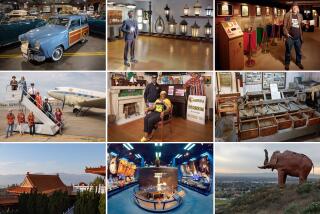‘AMERICAN MASTERS’ IMPRESSIVE
- Share via
SAN DIEGO — He has been dubbed the world’s most powerful art collector. But Baron Hans Heinrich Thyssen-Bornemisza believes in sharing the visual wealth of his extensive collection--1,400 paintings--and frequently packages selections of his holdings, putting them on the road as impressive traveling exhibits.
“American Masters: The Thyssen-Bornemisza Collection” opened its only West Coast presentation Saturday at the San Diego Museum of Art. Southern Californians last saw one of the baron’s exhibitions in 1980 when an Old Masters exhibit appeared at the Los Angeles County Museum of Art.
This exhibit surveys more than 200 years of American art. The “American Masters” show began two years ago at the Vatican Museums in Rome. It was also presented at its home, La Favorita, the baron’s villa on Lake Lugano in Switzerland, before its American tour.
From the 18th-Century portraiture of John Singleton Copley to the mid-1970s photo-realism of Richard Estes, the exhibit touches just about every major and minor movement in this country’s art history. Key painters from the Hudson River School, Luminism, Early Modernism, Abstract Expressionism and Pop Art are represented.
The baron and Simon de Pury, the curator of his collection, strolled through the museum’s galleries and talked to a visitor as workers put the finishing touches on the exhibition two days before the opening. Painters touched up the walls. A vacuum cleaner roared to life, drowning out the baron as he explained how he began his American collection with 20th-Century painters.
Baron Hans Heinrich Thyssen-Bornemisza’s collection was started and built to world-class status by his father, whose name was the same. After the death of his father in 1947, the current baron assumed control of the family’s mining and manufacturing empires in Germany and began to reassemble the art collection, which had been divided among his siblings.
The son’s first two American acquisitions--a 1951 geometric cityscape by Charles Sheeler and “Grand Central Terminal,” a 1915 cubist abstraction by Max Weber--are in this exhibit.
The baron posed, at a photographer’s request, before Copley’s 1767 portrait of Judge Martin Howard, grinning a judicial smile of his own. Nearby, a museum technician scaled a dolly and focused lighting instruments on a larger than life John S. Sargent portrait. As the baron watched, the hair of Millicent, Duchess of Sutherland, painted in 1904, took on its auburn color as her alabaster cheeks seemed to glow in the light.
The baron apologized that the most recent period represented by the 115-painting exhibition was not as strong as he would like. Paintings from his collection form two other complete exhibitions. A show of 20th-Century Masters has siphoned off some important works by Mark Rothko, Edward Hopper and Clifford Still, and their absence has taken some of the punch out of the later modernist portion of the San Diego exhibit, he said.
Still, the depth of this extensive collection is such that the “American Masters” exhibit includes three Charles Burchfields, four Edward Hoppers, four Georgia O’Keefes, a Willem de Kooning and a Jackson Pollock among about 50 20th-Century paintings that might be labeled “modern art.”
Besides having what has been called a natural collector’s eye for great art, the baron developed the habit of poring over art histories as he focused on a new school of art. After acquiring a substantial amount of 20th-Century American art, the baron began to collect his way backward through American history. The result is an impressive survey of often-neglected periods of American art.
Landscapes are his particular favorite. “I was born in Holland. The greatest landscape painters were in Holland. I loved the unspoiled landscapes of the Americans.”
The landscapes by the Luminists, who used subtle light effects, are one of this exhibition’s strengths. James G. Clonney’s “Fishing Party on Long Island,” Jerome B. Thompson’s 1872 “Pastoral,” and landscapes by Martin J. Heade and Albert Bierstadt speak of his passion in collecting. One of the baron’s large Heade seascapes hangs in the Swiss residence that President Reagan is occupying during the U.S.-Soviet summit meeting.
Perhaps the most recognized and valuable piece in the exhibit is one of the six Winslow Homer paintings. “The Signal of Distress” (1892) depicts oilskin-clad men about to launch a lifeboat in a turbulent sea. The baron paid $2 million for the painting.
The Thyssen-Bornemisza collection is considered to be the world’s second largest private collection, next to that belonging to Queen Elizabeth II of Great Britain.
Today most of the family’s industrial operations are run by the baron’s son, Georg-Heinrich. “I spend 60% of my time on art,” the baron said. He hopes to see his art used in the service of world peace. He has traded exhibitions of his European masters with the Hermitage in Leningrad and the Pushkin Museum in Moscow in return for an exhibit of Russian impressionist paintings.
The “American Masters” collection, which has been seen in Denver, San Antonio, Tex., and New York, will move to Palm Beach and New Orleans before traveling to Europe and the National Gallery of Ireland in Dublin. The baron hopes this exhibit will be shown in the Soviet Union, “so they can see that there are quite normal people living in this country.”
Co-sponsored by a $110,000 grant from the John M. and Sally B. Thornton Foundation, the exhibit will continue through Jan. 12.
More to Read
The biggest entertainment stories
Get our big stories about Hollywood, film, television, music, arts, culture and more right in your inbox as soon as they publish.
You may occasionally receive promotional content from the Los Angeles Times.










